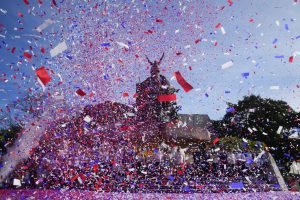In February 1986, the “conjugal dictatorship” of the Philippine dictator Ferdinand E. Marcos and his wife Imelda crumpled during an army-backed campaign of mass public demonstrations that came to be known as the People Power Revolution. Every year since, political activists and ordinary Filipinos have gathered to mark the democratic uprising and commemorate the vicissitudes of Marcos’ rule.
During his 21-year reign, during 14 of which he ruled under Martial Law, Marcos oversaw the murder, imprisonment, and torture of thousands of Filipinos, and sucked billions from the national accounts. After being forced out of power in 1986, Marcos fled with his family to Hawaii, where he died three years later.
All of these themes were front and center last Saturday when, as The Associated Press reported, about 1,400 demonstrators, some of them survivors of Martial Law, gathered at the People Power Monument along the Epifanio de los Santos Avenue (EDSA) in central Manila, a primary site of the protests, to mark the anniversary. Some waved Philippine flags, while others held placards that read “Never forget.”
The one crucial difference with this year’s commemoration was that a Marcos – specifically, the son of a dictator ousted from power 37 years ago this week – is ruling once again from the Malacañang Palace. Ferdinand “Bongbong” Marcos Jr., who fled with his parents to Hawaii in 1986, was elected president last May, capping off his family’s triumphant return to the heights of Philippine politics – and offering a reminder that the People Power Revolution remains unfinished, to the extent that it ever really began.
This disjuncture was dramatized by the surreal fact of Marcos having to acknowledge the symbolism of the People Power revolt, without mentioning exactly what the aims of the revolution were, nor the identity of its main antagonists. In a message on Facebook, the Philippine leader declared that he was “one with the nation in remembering” the EDSA Revolution, without citing the event as a democratic milestone, as his predecessors had done.
“As we look back to a time in our history that divided the Filipino people, I am one with the nation in remembering those times of tribulation and how we came out of them united and stronger as a nation,” Marcos said in the message.
Marcos added, “I once again offer my hand of reconciliation to those with different political persuasions to come together as one in forging a better society – one that will pursue progress and peace and a better life for all Filipinos.”
More gestures followed: Marcos sent a wreath of flowers to the People Power Monument, which was built to commemorate the events of the revolution that toppled his family from power, and declared February 24 a national holiday, referencing “the historical significance of the EDSA People Power Revolution Anniversary.”
At the same time, Marcos made no apology for any of the atrocities that were committed during Marcos Sr.’s period of Martial Law, nor for the missing millions whose recovery he has for years actively opposed. As many critics of Marcos, particularly those on the left, noted, Marcos’s reference to reconciliation stopped short of any meaningful degree of justice for the victims of his father’s rule, or even limited accountability for the perpetrators.
“Reconciliation can only happen when there is justice,” Renato Reyes, secretary general of the left-wing Bagong Alyansang Makabayan, was quoted as saying. “Without any meaningful recognition of the abuses of the past, how can there be genuine reconciliation?”
Alongside Saturday’s commemorations, left-wing activists carried an effigy that depicted Marcos as a pest, drawing a direct line between the abuses of the past and the impunity of the present. As Butch Abad, a prominent activist who participated in the 1986 uprising, told the AP, “Unfortunately, we stopped at ousting a dictator and did not pursue a deepening of democracy.”
All in all, Marcos’ statement laid bare the gap between the symbolism of EDSA – an event depicted as a grand casting off of dictatorship and embrace of democratic norms – and the reality: that the ancien regime and the system that emerged after 1986 were marked by quiet continuities as much as rapturous change.
Indeed, the return of the Marcos clan is only the most jarring of these continuities, which are perhaps best represented by the concentration of the country’s wealth in the hands of a small number of powerful political clans, much as it was before 1986 – and indeed, far back into the country’s colonial history. With a Marcos once again in office, it is more apparent than ever that EDSA was less a revolution than a restoration of an old order. This year’s commemorations are a reminder not just of how far the Philippines has come, but also of how far it has yet to go.
































